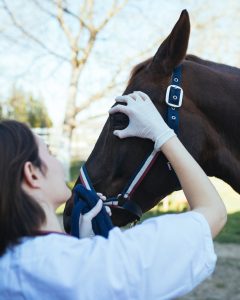Horses have large, prominent eyes that put them at higher risk for sustaining traumatic eye injury, and fungi can infect these corneal defects and cause significant pain, and potential blindness. Our Veterinary Vision Center team explains how your horse’s vision could be threatened by this complication.
Corneal ulcers in horses
Corneal ulcers most commonly affect horses after a traumatic incident affects their eye. This could be caused if the horse runs into an object, has violent contact with another horse, a foreign object enters their eye, or dust irritates their eye. In addition, pathogens such as bacteria or fungi can be a primary cause of a corneal ulcer. If your horse has a corneal ulcer, signs you will likely see include squinting or refusing to open the affected eye, swollen eyelids, excessive tearing, eye redness, a cloudy appearance to the cornea, and potentially a mucoid ocular discharge. Prompt veterinary attention is required if you see any of these signs in your horse.
Your horse’s exposure to fungi
Fungi are abundant in your horse’s everyday life. These microorganisms can normally be found in hay, grasses, shavings, straw, and dust, and many healthy horses have fungi living on their corneal surface. When ocular trauma causes a defect in the corneal tissue, these fungi can colonize the corneal stroma and cause infection. Louisiana’s mild temperatures make horses here especially prone to fungal infections. If your horse has a corneal ulcer, and the lesion does not respond to antibiotics and pain medication, they may have a fungal infection.
Diagnosing fungal corneal ulcers in horses
Fungal corneal ulcers are typically extremely painful, and your horse will likely need sedation to allow adequate examination of their eye. We will apply a fluorescein stain to your horse’s eye, to check for corneal epithelium disruptions, which will appear as a bright green spot on your horse’s eye. Your horse’s eye may appear white or grey around the defect, and blood vessels may appear on the corneal surface, migrating from the eye margin (i.e. limbus). Then, we will apply another stain, called a rose bengal stain, to check for ocular surface damage typically caused by fungal infection. In addition, we will need to take corneal tissue for cytology examination and culture. Fungal cultures typically take 48 to 72 hours to grow, and treatment will likely be started before we get the results, to prevent disease progression.
Treating fungal corneal ulcers in horses
The treatment approach will depend on how severely your horse’s eye is affected.

- Superficial fungal ulcers — Treatment typically involves systemic pain medication, and topical antifungals and antibiotics. Topical atropine is also used to dilate the pupil and help alleviate pain. In addition, the horse’s serum can be used to treat their eye. When administered topically, serum reduces tear film and corneal protease activity in corneal ulcers in horses. The administration frequency will depend on the severity of your horse’s condition. If medical management is not successful, a procedure called keratectomy may be necessary. This procedure involves epithelial debridement using a topical anesthetic and a cotton swab or blade, to remove devitalized corneal tissue and dead fungi.
- Deep fungal ulcers — An ulcer is considered deep when more than the initial third of the corneal stroma is lost. If the corneal epithelium and stroma are completely destroyed, the ulcer is called a descemetocele, because the remaining tissue at this level is called Descemet’s membrane. Deep ulcers and descemetoceles are fragile and should be handled carefully, because the remaining corneal tissue can easily perforate. Medical management should include systemic pain medication, topical antifungals, antibiotics, atropine, and serum. The treatment frequency is typically every hour. Surgical procedures to manage these lesions include keratectomy to remove the necrotic and infected tissue, replacing the missing cornea using a corneal transplant or collagen product, and performing a conjunctival graft to support the damaged cornea. In this procedure, a thin layer of conjunctiva is relocated to cover the corneal ulcer, and sutured in place using resorbable sutures. In some cases, the eyelids may temporarily be completely or partially sewn shut to help improve graft adherence.
- Melting ulcers — Severe corneal inflammation, as seen in a fungal infection, can result in rapid corneal liquefaction and perforation, caused by proteolytic enzymes. Medical management involves systemic pain medication, topical antifungals, antibiotics, atropine, and serum, but melting ulcers are typically difficult to control with medical treatment alone. A keratectomy, conjunctival replacement, and conjunctival graft are often needed to save the eye.
Since these lesions need hourly treatment, your horse may heal better in an equine hospital or rehabilitation facility, where they can be treated around the clock. Installing a subpalpebral lavage system (SPL) can also significantly facilitate treatment. A catheter is placed under your horse’s eyelid, so you can administer medication through a port secured to their mane, to be delivered to their cornea. In some cases, the eye cannot be salvaged, and enucleation is necessary to alleviate your horse’s pain.
Fungal corneal ulcers can cause your horse considerable pain, and potentially result in vision loss. Ensuring your horse receives prompt veterinary attention any time they exhibit tearing, eye redness, eye swelling, or squinting will help protect them from this serious complication. If your horse has a fungal corneal ulcer, contact our team at Veterinary Vision Center, so we can determine the best treatment plan to save their eyesight.







Leave A Comment